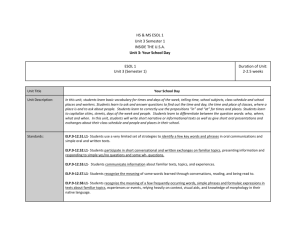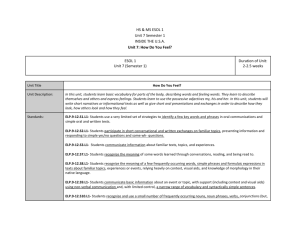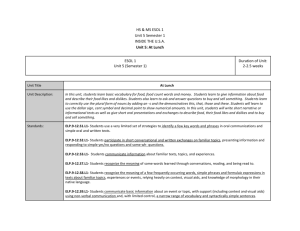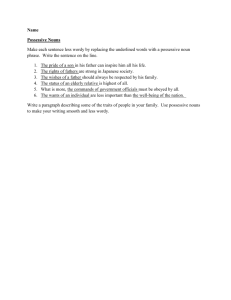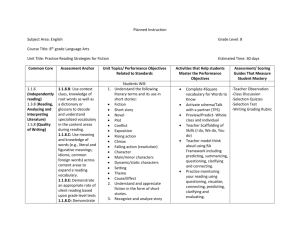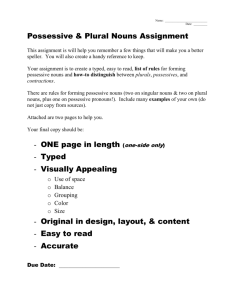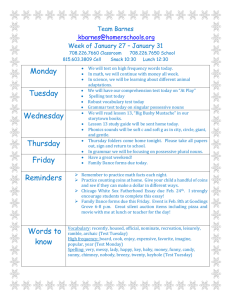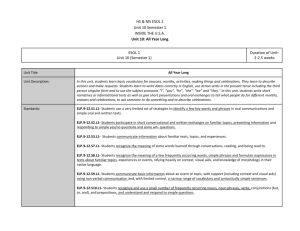Unit 9 Semester 1
advertisement
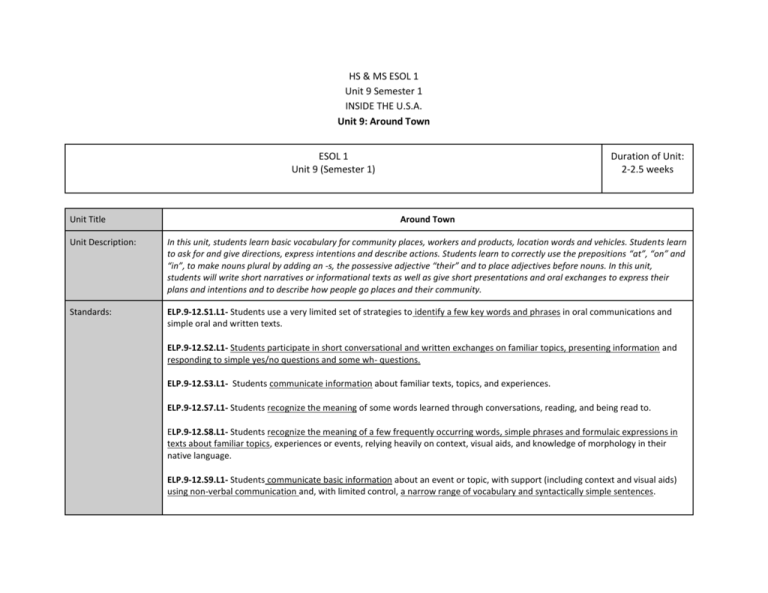
HS & MS ESOL 1 Unit 9 Semester 1 INSIDE THE U.S.A. Unit 9: Around Town ESOL 1 Unit 9 (Semester 1) Unit Title Duration of Unit: 2-2.5 weeks Around Town Unit Description: In this unit, students learn basic vocabulary for community places, workers and products, location words and vehicles. Students learn to ask for and give directions, express intentions and describe actions. Students learn to correctly use the prepositions “at”, “on” and “in”, to make nouns plural by adding an -s, the possessive adjective “their” and to place adjectives before nouns. In this unit, students will write short narratives or informational texts as well as give short presentations and oral exchanges to express their plans and intentions and to describe how people go places and their community. Standards: ELP.9-12.S1.L1- Students use a very limited set of strategies to identify a few key words and phrases in oral communications and simple oral and written texts. ELP.9-12.S2.L1- Students participate in short conversational and written exchanges on familiar topics, presenting information and responding to simple yes/no questions and some wh- questions. ELP.9-12.S3.L1- Students communicate information about familiar texts, topics, and experiences. ELP.9-12.S7.L1- Students recognize the meaning of some words learned through conversations, reading, and being read to. ELP.9-12.S8.L1- Students recognize the meaning of a few frequently occurring words, simple phrases and formulaic expressions in texts about familiar topics, experiences or events, relying heavily on context, visual aids, and knowledge of morphology in their native language. ELP.9-12.S9.L1- Students communicate basic information about an event or topic, with support (including context and visual aids) using non-verbal communication and, with limited control, a narrow range of vocabulary and syntactically simple sentences. ELP.9-12.S10.L1- Students recognize and use a small number of frequently occurring nouns, noun phrases, verbs, conjunctions (but, or, and), and prepositions, and understand and respond to simple questions. Vocabulary Language Functions Writing & Speaking Conventions Reading Goals: Students will be able to use and understand vocabulary for community places, workers and products, vehicles, location words and words for people. Students will be able to give directions, express intentions and describe actions. Students will be able to write short narratives or informational texts and give short oral presentations or exchanges to give directions, express intentions and describe how people go places and their community. Students will be able to correctly use the prepositions “at” and “on.” Students will be able to make nouns plural by adding an -s. Students will be able to use the possessive adjective “their.” Students will be able to correctly use the prepositions “in” and “on”. Students will be able to correctly put adjectives before nouns. Students will be able to read and understand short narrative or informational texts about familiar topics. Students will be able to retell a story using key words and phrases. Learning Targets: I can use words for community places and workers. I can ask for and give directions. I can write short narratives or informational texts and give short presentations or oral exchanges to give directions, express intentions and describe how people go places and their community. I can correctly use “at” and “on.” I can accurately retell the book Getting from Here to There including relevant details, appropriate vocabulary and mostly accurate language patterns and pronunciation. I can use location words. I can tell what I plan to do by using expressions like: I am going to….., I will….. I can make nouns plural by adding an -s. I can use words for community places and I can tell how people go to places by using expressions I can use the possessive adjective “their.” products. I can use words for vehicles. like: They ride (on/in)....., They take….. I can correctly use “in” and “on.” I can put adjectives before nouns. Unit of Study Assessment Checklist Student Name Learning Target Notes E = Exceeds M = Meets A = Approaching D= Doesn’t Meet “Around Town” Assessment Rubric Unit 9: Semester 1 (To reach the next level, a student must master the previous level’s task.) Exceeds Meets Doesn’t Meet Students will be able to use and understand vocabulary for community places, workers and products, vehicles, location words and words for people. I can use words for community places and products. Students will be able to give directions, express intentions and describe actions. I can ask for and give directions. Students will be able to write short narratives or informational texts and give short oral presentations or exchanges to give directions, express intentions and describe how people go places and their community. I can write short narratives or informational texts and give short presentations or oral exchanges to give directions, express intentions and describe how people go places and their community. Students will be able to correctly use the prepositions “at” and “on.” Students will be able to make nouns plural by adding an -s. Students will be able to use the possessive adjective “their.” Students will be able to correctly use the I can correctly use “at” and “on.” I can correctly use “in” and “on.” I can use words for community places and workers. Approaching I can put adjectives before nouns. I can use location words. I can use words for vehicles. I can tell how people go to places by using expressions like: They ride (on/in)....., They take….. I can tell what I plan to do by using expressions like: I am going to….., I will….. I can use the possessive adjective “their.” I can make nouns plural by adding an -s. prepositions “in” and “on”. Students will be able to correctly put adjectives before nouns. Students will be able to read and understand short narrative or informational texts about familiar topics. Students will be able to retell a story using key words and phrases. I can accurately retell the book Getting from Here to There including relevant details, appropriate vocabulary and mostly accurate language patterns and pronunciation.
